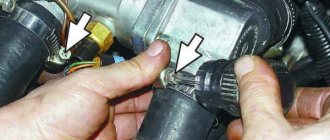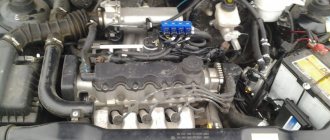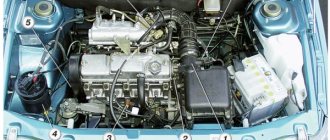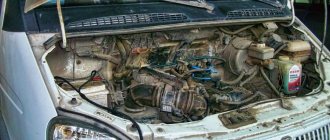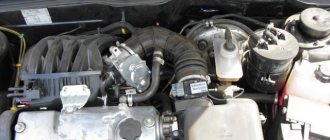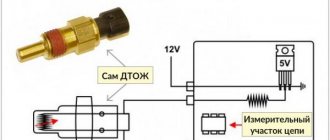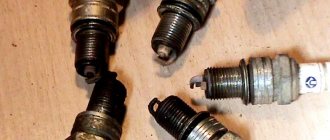VAZ-2114 – the engine gets hot: causes and repairs. Thermostat VAZ-2114
An internal combustion engine is called that because the process of fuel combustion occurs inside its cylinders. In this case, a huge amount of thermal energy is released, which, thanks to the crank mechanism, is converted into mechanical energy. The temperature often exceeds 2000 degrees. No metal, no matter how strong and stable it is, can withstand such a load for long. It is precisely in order to reduce the thermal load and ensure normal temperature conditions for engine operation that the cooling system serves. If it malfunctions, the car’s power unit begins to overheat, as a result of which engine parts expand, lubricant boils, and gaskets burn out. The result of such a destructive process may be failure of the elements of the piston group and the cylinder head. To prevent such an outcome, it is important to know the possible causes of engine overheating and be prepared to eliminate them immediately.
Low operating temperature
The opposite of overheating is a nuisance that is “underheating” of the engine - a situation when the engine temperature cannot reach normal operating temperature.
It can be caused by the following reasons:
- broken cooling system sensor;
- thermostat failure;
- fan is not working properly.
In the first case, you should simply replace the sensor with a new, similar one (it is inexpensive). If after the replacement the temperature rises to normal, then the reason was precisely in the sensor, and not in incorrect engine operation. Otherwise, you should check the operation of the thermostat.
The surest way to check this, as in the previous case, is to replace the part (thermostat). If after this the engine temperature began to rise to normal, then the cause of underheating (and in some cases, overheating) was precisely in it.
If not, then all that remains is to check the cooling fan for functionality. In some cases, its circuit may close, causing the fan to operate even at a low engine temperature (which will lead to underheating). In order to carry out the test, you will have to “ring” the entire electrical circuit of the fan for short circuits.
If none are found, you can try replacing the fan with a new one and again monitor the temperature readings.
By following the instructions above, you can easily eliminate the causes of both too high and too low engine temperatures in your car.
Boiling point of antifreeze
Initially, on the first cars, water was used as a coolant. The boiling point of water is 100 degrees Celsius. The reasons why it was decided to abandon water lay in its low boiling point, which was not designed for heavy loads, and its freezing in winter. After all, when it froze, it turned into ice, and its volume expanded significantly. Such phenomena led to the fact that the cylinder block simply cracked and the entire engine failed, the block of which could only be replaced.
Such disadvantages are absent in antifreeze. The fact is that antifreeze has a certain chemical composition that allows it to withstand fairly low temperatures, which makes it possible for the car to operate normally in winter. In addition, the boiling point of antifreeze is much higher than that of water and is 125 degrees Celsius.
However, such a value as temperature can vary from 108 to 125 degrees. This is due to the chemical composition of the coolant, which, accordingly, changes the boiling point. Changing the composition makes the production of antifreeze more economical, the price for it falls, but at the same time, the boiling point also decreases. Therefore, when buying antifreeze, you should not pay special attention to savings, since the proper cooling of your engine will depend on this.
You should be especially careful with antifreeze with qualitative inconsistencies. Typically, such coolant costs quite little, which is tempting for drivers. However, the boiling point of some specimens is even 85 degrees, which is dangerous for a car engine.
Therefore, be careful and do not buy low-quality coolant. This will save you a lot of nerves and money.
What should the temperature be?
According to the international automobile convention of December 1, 1992, where 92 representatives of the auto industry gathered, it was decided to establish a single standard for engine operating temperature.
This indicator is 90 degrees Celsius with a maximum permissible deviation of no more than 3 degrees Celsius.
With the development of the automotive industry and a sharp leap in technology in the 2000s, in 2004 it was decided to revise this indicator. So, having considered all the facts and analyzed the design features of many cars, it was decided to establish a floating indicator with marginally acceptable standards, which, today, is 85-105 degrees Celsius.
Radiator clogged
The radiator can be clogged from the outside and inside. External contamination is associated with dust and other debris, as well as insects, entering the honeycombs. This worsens heat transfer and is manifested by frequent operation of the fan and a long operating time.
Clogged engine radiator honeycomb
A good high pressure washer solves the problem. If the radiator has been in use for a long time, the car cools and heats up worse due to deformation of the honeycombs. You can “cure” this problem by replacing the radiator.
The radiator rarely clogs from the inside. This usually occurs due to poor quality antifreeze, driving on water, or as a “side effect” of radiator sealants. The presence of this problem is indicated by the coolant: it becomes cloudy, oil stains and solid particles are visible in it. Flushing the cooling system of the VAZ 2114 is carried out by completely draining the antifreeze with distilled water with the addition of radiator cleaning agents.
According to statistics, three-quarters of the answers to the question why the engine of the “four” heats up are associated with one of the malfunctions listed above. You can diagnose and eliminate them yourself without involving the services of a car service. If none of the above methods solves the problem, it is better to contact a specialist for diagnosis.
Other reasons for overheating of the VAZ-2114:
- dashboard malfunction;
- pump malfunction;
- Leaking cylinder head gasket.
Basic cooling system malfunctions
The reason why the operating temperature range on a VAZ-2114 engine with 16 or 8 valves may change is the failure of parts of the cooling system. Almost every component of it is capable of changing the engine temperature in one direction or another.
- If the radiator is faulty, then most often the temperature rises. First of all, this is due to its clogging. It is enough to clean the grille of this part from debris and dust and the temperature indicators return to normal. If the radiator leaks, then more expensive repairs will be required, including soldering it or completely replacing it. Nevertheless, the radiator is one of the most reliable parts of the VAZ-2114.
- The pipes of this car are the weaker components of the cooling system. An increase in temperature in the engine is associated with wear of the pipes, which causes delamination and cracks to appear in them. Through these damages, coolant leaks out, causing the temperature in the power unit to rise.
- If the water pump fails, you will have to replace it. This unit may produce too little pressure or leak altogether, which will practically stop the circulation of fluid in the system.
- Most often, car enthusiasts are faced with a faulty thermostat. This is a rather capricious part that has to be changed from time to time. In winter, jamming of the thermostat is not so bad; it will be stuck in a small circle, this will be enough for the normal functioning of the engine. In the summer, the radiator fan will work continuously, but it will still not be able to cope with the increase in temperature. The thermostat must be replaced as soon as possible after it breaks. Experienced car enthusiasts recommend installing a more advanced model of this element from a Lada Granta car.
- If the fan installed on the radiator malfunctions, the power plant will boil in almost 100% of cases, especially when the thermostat fails at the same time.
Sometimes the engine readings are not within the operating temperature range due to a faulty sensor. In this case, the driver will not notice changes in the operation of the engine, but will see an error on the on-board computer screen. Incorrect impulses sent by this thermocouple will cause many vehicle systems to not work correctly. Before looking for a problem in the cooling system, test the sensor; perhaps it is the sensor that is transmitting incorrect readings.
Liquid pump failure
The role of the pump in the cooling system is to create pressure through which the refrigerant circulates. Its failure can not only cause the VAZ-2114 engine to overheat, but also cause a malfunction of the gas distribution mechanism drive. The fact is that the liquid pump is driven through a gear by a timing belt. Therefore, if the pump fails, it immediately affects the performance of the entire drive. In this case, the fluid pump and possibly the timing belt will need to be replaced.
Operating range on the VAZ-2114
If we consider cars produced at the AvtoVAZ plant, including the VAZ-2114, then the operating temperature range for engines is considered to be 87-103 degrees Celsius. If we consider this issue from the point of view of functionality, then this is the optimal indicator.
If the temperature drops below the limit level, then the Samara-2 engine loses dynamics and power, and if it is higher, it can simply boil and cause great damage. Therefore, if malfunctions associated with the cooling system occur, they must be eliminated as soon as possible.
Fan sensor malfunction
Failure of the fan switch sensor leads to the fact that during slow driving the radiator does not receive any forced airflow. In other words, the fan simply does not turn on and the liquid does not cool. Checking the sensor is easy. For “fourteeners” with carburetor engines, it is enough to turn on the ignition, disconnect the terminals from the sensor located on the radiator, and short them together. If the fan starts working, the sensor needs to be replaced. If the VAZ-2114 engine (8-valve injector) heats up, with the ignition on, simply remove the terminals from the coolant temperature sensor located on the right of the cylinder block. The electronic control unit will command the engine to operate in emergency mode, and the fan will have to turn on. If this happens, replace the sensor.
But there is one more nuance here - a fuse. If it burns out, the fan, of course, will not turn on. In the mounting block under the hood, find fuse F4 or F8. It is indicated by the corresponding symbol - a propeller. Remove it from the socket and check it with a tester. Replace if necessary.
CAUSES OF ENGINE OVERHEATING
Overheating can be caused by many reasons, all of them are related to a malfunction of the cooling system, or the quality of the coolant, as well as contamination of the cooling system jacket, which impairs the fluid throughput. It is important to use high-quality spare parts, otherwise the reasons below will happen suddenly. Let's look at each of the reasons.
LOW COOLANT LEVEL
The most common problem is a lack of coolant in the system. Coolant, in the form of antifreeze or antifreeze, constantly circulates through the system, removing heat from heated engine parts. If the coolant level is insufficient, the heat will not be removed sufficiently, which means an increase in temperature will be inevitable.
If it is not possible to add coolant, then turn on the heater to reduce the likelihood of overheating. As a last resort, add regular or distilled water, after which the cooling system must be flushed and then filled with fresh antifreeze. At temperatures above 90 degrees, you should immediately stop the car, turn off the ignition, and allow the engine to cool.
ELECTRIC COOLING FAN FAILED
The electric fan forces cool air onto the radiator, which is especially necessary when driving at low speeds when there is insufficient air flow. The fan can be installed either in front or behind the radiator. If the temperature arrow starts to rise, stop the car and check the fan for serviceability. Reasons for fan failure:
- electric motor failed
- connector oxidized
- fan relay burnt out
- The internal combustion engine temperature sensor has failed.
To check the fan, remove the connectors from it and connect the wires directly to the battery, which will allow you to determine the cause of the failure.
THERMOSTAT FAULT
The thermostat is one of the main elements of the cooling system. The cooling system has two circuits: small and large. A small circuit means that fluid circulates only through the engine. In a large circuit, fluid circulates throughout the system. The thermostat helps you quickly reach and maintain operating temperature. Thanks to the sensitive element, which opens the valve at 90 degrees, the liquid enters a large circle, and vice versa. The thermostat is considered faulty in two cases:
- operating temperature of the coolant is not reached
- the power unit tends to overheat.
The thermostat can be located directly in the cylinder block, in a separate housing, or as one unit with a temperature sensor and pump.
BROKEN COOLING FAN BELT
On vehicles with a longitudinally mounted engine, the fan can be driven by a drive belt from the crankshaft pulley. In this case, the fan works forcibly. The service life of the drive belt is from 30 to 120 thousand km. Typically, several units are driven by one belt. When a belt breaks, the internal combustion engine immediately tends to overheat, especially when the speed decreases. If you have a domestic car with a belt-driven fan, it is recommended to install an additional electric fan to avoid unpleasant incidents.
DIRTY RADIATOR
Once every 80-100 thousand kilometers it is necessary to flush the radiator along with the entire cooling system. The radiator becomes clogged for the following reasons:
- untimely replacement of antifreeze
- use of low-quality liquid
- application in water system
- application of cooling system sealant.
To wash the radiator, you should use special compounds that are added to old antifreeze; the engine runs on this “mixture” for 10-15 minutes, after which you need to remove water from the system. It is advisable to remove the radiator and wash it with water under pressure, inside and out.
Antifreeze is boiling in the expansion tank
Why does antifreeze boil? This question is asked by many motorists who have encountered this phenomenon while driving a car. There are many reasons why antifreeze can boil, as well as ways to eliminate them.
- Reason 1 . The coolant level in the expansion tank is too low. This happens if antifreeze was poured in insufficient quantities. Its level should be between the “min” and “max” marks on the tank body. However, it is also possible that there is a coolant leak, which can be anywhere. After eliminating the leak, simply pour the missing amount of antifreeze into the tank.
Water pump
The water pump or water pump should drive coolant through the system, but if this unit breaks down, low pressure can lead to slow cooling, which in turn will increase the operating temperature of the engine. Often, the water pump will simply leak and driving the car will no longer be possible.
The fault can be easily treated by replacing the part.
Tank cap
Another cause of overheating may be a plug in the expansion tank. It is designed in such a way as to maintain a certain pressure in the system, which is higher than atmospheric pressure. This is necessary to ensure that the water in the antifreeze or antifreeze does not boil at 100 degrees Celsius. If the plug is faulty and does not hold the required pressure, the coolant may boil prematurely. This will not cause significant overheating of the motor, but may cause problems with the operation of the system.
Where is the Temperature Sensor on the VAZ 2115
Where exactly is the temperature sensor located on the VAZ-2115
The temperature sensor built into the VAZ-2115 prevents engine overheating, which means that you can ensure the safety and security of important vehicle components.
Video and photo guide to replacing the speed sensor with a VAZ 2110 speed sensor, p. Installation unit for relays and relay fuses VAZ 2109. Where is the stove relay located on the VAZ 2109.
The engine overheating signal comes from the temperature meter sensor, but in Russian cars this device can hardly be called reliable.
Where to find a temperature sensor in a VAZ-2115
The entire car cooling system is divided into several types:
- air;
- watery;
- combined. combines 4.5 types at the same time.
The VAZ-2115 has a built-in water cooling system, which provides refilling with antifreeze or higher quality antifreeze. In fact, the mechanism consists of the following multifunctional parts:
- engine cooling radiator;
- radiator fan;
- heater radiator;
- jacket cooling device;
- coolant pump;
- expansion tank;
- connecting pipes;
- antifreeze temperature sensor.
Beginners are wondering where the coolant on the VAZ-2115? A device located between the thermostat, not the cylinder head, directly above the radiator tube, connects the part to the system with the introduction of 4.5 wires.
There is another meter installed nearby, but note that this common hearing aid is associated with a positive point in this panel.
READ Temperature Sensor VAZ 2115 Where is it located
A careful study of the design allows you to see the resistor in the sensor, where the resistance is determined based on the warming up of the VAZ-2115 engine.
Temperature sensor malfunction
Knowing the location of your device, simply get rid of the damage yourself. People tell me where the fuel pump is on the VAZ 21099, the fuel pump, the injector. The main reasons for device malfunction, according to experts, are:
- lack of contact;
- gap This is not a deterioration in insulation, a loss of contact integrity;
- the device is completely out of order;
- The fan doesn't work so well.
Signs that the driver of a VAZ-2115 should not require diagnostics of the state of the freezing temperature sensor are:
replacement Temperature sensor VAZ 2115 coolant
Replacement Video Temperature Sensor
coolant for
VAZ 2115
(2113, 2114).
Replacing the coolant temperature sensor (DOTH) VAZ 2108,2109,21099,2110,2111,2112,2113,2114
replacing temperature sensor
antifreeze (DOTH)
VAZ
2108,2109,21099,2110,2111,2112,2113,2114
2115
.
- fan operation with a cold machine engine;
- the engine is warm but still refuses to run;
- Fuel consumption is gradually and steadily increasing.
How to check the temperature sensor for status
DTOZH signals the heating temperature of antifreeze on the dashboard of the VAZ-2115. You can easily check the status of your device by following these instructions:
- Drive your car and watch the dashboard. Hello, today we will show you where the fuse box is on the VAZ 2108, 2109, 21099 and what each of them means. When the needle is at the maximum value and the engine is cold, disconnect the contacts from the temperature measuring device. If the needle suddenly drops to the lowest possible level, then the device has actually failed and needs to be replaced.
- If the arrow is still at the maximum, consider the contact; perhaps it is shorted to the weight of the VAZ-2115.
- If the engine warms up well and the needle continues to jump or is opposite zero, start checking for fuse wear.
- If the fuses are not worn out, the ground contact of the VAZ-2115 remains closed. Follow the arrow position, if it takes off, it means the VAZ-2115 DTO is not working properly.
READ Outside Air Temperature Sensor Multitronics
How else to check the DTOZH:
- You will need a multimeter, it needs to be switched to ohmmeter mode. Maybe someone knows where the speed sensor and the Citroen Berlingo sensor are located. Self-repair of a generator on a VAZ 2110: where is it located. Equip yourself with a thermometer that measures over 100 degrees. Prepare a container that will not melt when exposed to hot coolant.
- Attach multimeter leads to the base of the housing and to the output of the measuring device.
- Place the installed sensor directly into the antifreeze and warm it up well.
- Look at the thermometer and ohmmeter readings. At a temperature of 30 degrees, the resistance should be 1350-1880 Ohms. If the temperature rises to 50 degrees, the resistance drops to 585-820 degrees. A temperature of 70 degrees corresponds to a resistance from 280 to 390 Ohms inclusive. If the antifreeze heats up to 90 degrees, the normal resistance is in the range of 155-196 ohms. Where is the charging relay located on the VAZ 2110? At 110 degrees the resistance is the lowest. from 87 to 109 kOhm.
Cooling radiator
You may ask, what if all the main elements of the cooling system except the fan are working properly, but on the VAZ-2114 the engine heats up when driving, because the oncoming flow of air, even at average speed, can easily replace the propeller? There can only be one reason - the cooling radiator lamellas are clogged. Dirt, dust, leaves, branches, insects - all this settles in layers day after day, not allowing air to blow through the slats.
To prevent this situation, the radiator must be periodically washed with a stream of water to remove contamination.
What is the operating temperature of the 8 valve VAZ-2114 engine
Many experienced and not so experienced car enthusiasts have encountered the fact that when operating a VAZ-2114, the engine may not warm up to the required operating temperature or may overheat. This is due to changes in the operating temperature inside the engine or some malfunctions that periodically occur in any car. The article will tell you what the operating temperature of the engine is, and will also tell you about the causes of malfunctions associated with this indicator.
What are the dangers of squeezing antifreeze out of the expansion tank?
The consequences of knocking antifreeze out of the system can be very different: it all depends on at what stage the problem was discovered. If the antifreeze has already dropped below the minimum mark, then the cooling system will not be able to protect the engine from overheating.
The reason for this is the fact that burning fuel releases a huge amount of heat, which starts the vehicle engine. But only a small part of the engine requires heating. And if the motor housing is also exposed to high temperatures, then the entire engine may begin to work incorrectly.
In addition, in modern cars the structures are made in such a way that the gaps and parts are located very closely to each other. For this reason, engine overheating will also lead to breakdowns of overhead cams, aluminum parts, and so on.
As mentioned above, antifreeze can be thrown out not only outside, but also inside, getting into the engine. This causes the engine oil to mix with antifreeze and lose its properties. This way the crankshaft can be locked.
In any case, it is recommended to carry out regular inspections of the vehicle in order to detect coolant leaks. The sooner the leak is detected, the less consequences the breakdown will have.
Where to find a temperature sensor in a VAZ-2115
The entire cooling system in cars is divided into several types:
- air;
- liquid;
- combined - combining 2 types at once.
The VAZ-2115 has a built-in liquid cooling system, which involves filling with antifreeze or higher quality antifreeze. In general, the mechanism consists of the following functional elements:
- a radiator that allows the engine to cool;
- radiator fan;
- heater radiator;
- cooling device jacket;
- pump pumping coolant;
- expansion tank;
- connecting pipes;
- antifreeze temperature sensor.
Beginners are wondering where the coolant temperature sensor is located on the VAZ-2115? The unit located between the thermostat and the head of the cylinder combination, directly on top of the cooling system pipe, connects the part to the system using 2 wires.
There is another meter installed nearby, but note that this additional unit is connected on one side to the instrument panel.
A careful study of the design allows you to see a resistor in the sensor, where the resistance is determined depending on the heating of the VAZ-2115 engine.
Temperature meter sensor malfunctions
- lack of contact;
- rupture and wear of insulation, loss of contact integrity;
- the device is completely out of order;
- The fan is not working well.
Signs that should alert the driver of a VAZ-2115 and prompt them to diagnose the condition of the antifreeze temperature sensor may be:
- fan operation when the machine engine is not warmed up;
- the engine is warmed up, but still refuses to function;
- Fuel costs are gradually and steadily increasing.
How to check the temperature sensor for serviceability
DTOZH signals the heating temperature of the antifreeze on the instrument panel of the VAZ-2115. The condition of the device can be easily checked by following these instructions:
- Start the car and watch the instrument panel readings. When the arrow is fixed at the maximum value and the engine is cold, disconnect the contacts from the temperature measuring device. If the arrow suddenly drops to the possible minimum, then the unit is really out of order and needs to be replaced.
- If the arrow is still at the maximum, consider the contact; perhaps it is shorted to ground on the VAZ-2115.
- If the engine heats up well, but the needle continues to jump or is opposite the zero value, start checking the wear of the fuses.
- If the fuses are not worn out, then it remains to close the contact to ground of the VAZ-2115. Monitor the position of the arrow; if it shoots up, it means the VAZ-2115 DTOZH is not functioning correctly.
How else to check the DTOZH:
- You will need a multimeter, it should be set to ohmmeter mode. Also equip yourself with a thermometer that can measure temperatures greater than 100 degrees. Prepare a container that will not melt under the influence of hot coolant.
- Fix the multimeter probes to the body base and the terminal of the measuring device.
- Place the attached sensor directly into a container with antifreeze and heat it well.
- Look at the thermometer and ohmmeter readings. At a temperature of 30 degrees, the resistance should be equal to 1350-1880 Ohms. If the temperature rises to 50 degrees, the resistance decreases to 585-820 degrees. A temperature of 70 degrees corresponds to a resistance from 280 to 390 Ohms inclusive. If the antifreeze is heated to 90 degrees, the normal resistance value is in the range of 155-196 Ohms. At 110 degrees the resistance is the lowest - from 87 to 109 Ohms.
How to change the temperature sensor on a VAZ-2115
- Dismantle the old model, first draining the antifreeze from the car.
- Using the key number 21, place the new unit in the right place.
- Apply heat sealant while tightening the threads.
- Fill in new antifreeze; before using this special product, it is advisable to clean the entire cooling system.
Why the new unit may not work:
- You may have bought a defective device, which is why experts recommend checking the serviceability of the product with a multimeter.
- If there was an antifreeze leak, there is a possibility of the generator getting dirty.
- Screw the sensor tighter.
Step-by-step video instructions for replacing the coolant temperature sensor can be viewed below:
Hi all. One day my temperature gauge on the dashboard went off scale. She crawled over 130, and when the car was started, she floated up and down, as she liked. and then it rose at all - did not fall. I didn’t believe that the two-contact coolant sensor was broken, because on the BC my temperature degrees were clearly displayed and the fan turned on as expected.
I decided that the instrument panel was broken. But at one service station they told me that the fluid temperature sensor goes to a different needle. It is single-contact, screws in horizontally and is slightly shorter than the second one that goes to the “brains” and the fan.
I purchased a new LUZAR sensor for 85 rubles. In terms of thread and nut width, it turned out to be larger than the old one. The nut was 21, but there was no such key at home and I tore off this sensor. Plus, he lied to me about the temperature. On a warm car it showed 70 degrees.
I went and bought another Kaluga one. This one speaks more or less the truth. But the readings of my old sensor coincided with the “vertically twisting” one. The old one turned out to be somehow different. It has a shorter thread and screws in easily and all the way. These two new sensors barely screwed in one by one, well, it’s good that at least antifreeze doesn’t leak through the threads.
The conclusion is this: there are two temperature sensors - one for the “brains”, the fan, the on-board computer. (It screws in vertically, is easy to change, costs a little more.
- the second one on the arrow (single-pin, screwed horizontally under the pipe), behaves strangely when screwed in.
Now I will look for and ask for a sensor like my old one (in the photo with an orange neck). He gave me temperature readings exactly the same as on BC.
- Major breakdowns of DTOZH
- Determining the malfunction of the coolant sensor VAZ 2114
- Replacing the DTOZH sensor VAZ 2114
If you don't want to stand on the side of the road and wait for your engine to cool down, you should occasionally look at the coolant temperature gauge. It should not cross the 90 degree mark.
Radiator replacement
If there is a need to replace the radiator, remember the first golden rule - the engine must be cold before dismantling the device. Therefore, if you just arrived at the garage, let the car sit for a couple of hours. Better yet, leave the car and come back tomorrow.
The replacement procedure itself is as follows.
- Unscrew the plug from the expansion tank and the cylinder and radiator plugs.
- Drain the coolant into a large container.
- Disconnect the radiator ventilation system from the battery.
- Remove the silicone pipes of the VAZ 2114 cooling system by disconnecting them from the radiator and tank.
- Remove the mounting bolts from the casing.
- Hold the radiator and remove the skin and fan together.
- This will completely free the radiator, so you can easily replace it with a new one.
- Assembly of the unit is carried out in reverse order. After replacing the radiator, start the engine and check the efficiency of the new unit.
